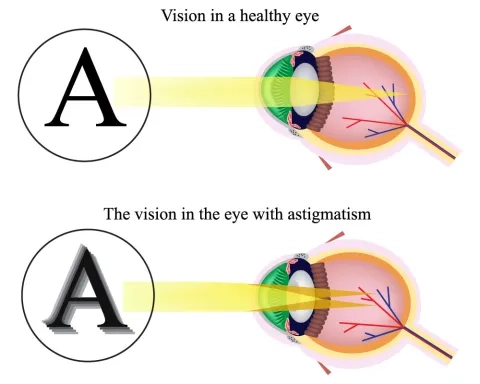What is Astigmatism?
What is Astigmatism?

Astigmatism is a common vision condition which happens due to refractive errors in the eye, which is similar to myopia (short-sightedness) and hyperopia (long sightedness). These conditions can cause blurred or distorted vision when at a distance and when near2.
Causes
A normal eye is naturally shaped round like a soccer ball. Astigmatism occurs when the cornea (the clear front cover of the eye) is irregularly shaped like a rugby ball or it can be due to the curvature of the lens inside the eye3. Due to the different curves, the light rays coming through will focus on two points on the retina instead of one. This can result in blurry vision or double vision especially if the astigmatism is severe.

The specific cause of astigmatism is unknown at the moment. Scientists have said that it can be hereditary due to genetics or congenital since birth3. Most children will have some degree of astigmatism early in life and it may improve or deteriorate as the eyes develop5. High amounts of astigmatism, if left undiagnosed, is one of the main causes of amblyopia or lazy eye in Singapore according to reports6. Hence, this can result in poor reading and concentration at school. Majority of children have no complaints even when they have high astigmatism. This is not unusual as they accept poor vision as ‘normal’ since they have not seen anything in focus at all since young.
Common signs and symptoms:
- Squinting
- Sensitivity to light
- Tilting the head to see better especially at words or letters
- Frequently rubbing eyes, even when not sleepy
- Excessive tearing and watery eyes
- Complaining of headaches or tired eyes
Treatment:
If the astigmatism is mild, no treatment will be required at all. Otherwise, corrective lenses i.e. prescription spectacles will mostly be the recommended solution for children
Early diagnosis is the best preventive measure to avoid development into other eye-related issues such as amblyopia or lazy eye.
According to American Optometric Association (AOA), the first eye check is recommended when the infant turns 6 months old7.
It is therefore, important to start with early and regular eye screening for young children so that we are able to follow up closely on the changes of the eyes and to detect early for any anomalies.
References:
- Do you have an Astigmatism? American Vision At The Court website. https://americanvisionatthecourt.com/conditions/do-you-have-an-astigmatism/ Accessed February 27, 2020.
- What is astigmatism? All About Vision website. https://www.allaboutvision.com/conditions/astigmatism.htm/ Accessed February 27, 2020.
- What is astigmatism and how is it treated? Medical News Today website. https://www.medicalnewstoday.com/articles/158810.php. Accessed February 27, 2020.
- Astigmatism: What Is It and How Does It Impact Your Vision? Intro Wellness website.https://introwellness.com/eyes/astigmatism/
- Astigmatism in children. Eye Consultants of Pennsylvania Website. https://www.eyeconsultantsofpa.com/astigmatism-children/. Accessed February 27, 2020.
- Astigmatism 'common' in kids with vision problems. The Straits Times website. https://www.straitstimes.com/singapore/health/astigmatism-common-in-kids-with-vision-problems. Accessed February 27, 2020.
- Infant Vision: Birth to 24 Months of Age. American Optometric Association. https://www.aoa.org/patients-and-public/good-vision-throughout-life/childrens-vision/infant-vision-birth-to-24-months-of-age. Accessed February 27, 2020.
Recent Blog Posts
- 19 Oct 2022
- 19 Oct 2022
- 19 Oct 2022
- 19 Oct 2022
- 19 Oct 2022
